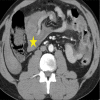Intraperitoneal anatomy with the aid of pathologic fluid and gas: An imaging pictorial review
- PMID: 37292244
- PMCID: PMC10246409
- DOI: 10.25259/JCIS_29_2023
Intraperitoneal anatomy with the aid of pathologic fluid and gas: An imaging pictorial review
Abstract
The peritoneum is a large serosal membrane enveloping the abdomen and pelvic organs and forming the peritoneal cavity. This complex relationship forms many named abdominopelvic spaces, which are frequently involved in infectious, inflammatory, neoplastic, and traumatic pathologies. The knowledge of this anatomy is essential to the radiologist to localize and describe the extent of the disease accurately. This manuscript provides a comprehensive pictorial review of the peritoneal anatomy to describe pathologic fluid and gas.
Keywords: Pathologic fluid; Pathologic gas; Peritoneal anatomy; Peritoneal spaces; Peritoneum.
© 2023 Published by Scientific Scholar on behalf of Journal of Clinical Imaging Science.
Conflict of interest statement
There are no conflicts of interest.
Figures





















Similar articles
-
Retroperitoneal anatomy with the aid of pathologic fluid: An imaging pictorial review.J Clin Imaging Sci. 2023 Dec 13;13:36. doi: 10.25259/JCIS_79_2023. eCollection 2023. J Clin Imaging Sci. 2023. PMID: 38205277 Free PMC article. Review.
-
The peritoneum, mesenteries and omenta: normal anatomy and pathological processes.Eur Radiol. 1998;8(6):886-900. doi: 10.1007/s003300050485. Eur Radiol. 1998. PMID: 9683690 Review.
-
Primary and secondary disease of the peritoneum and mesentery: review of anatomy and imaging features.Abdom Imaging. 2015 Mar;40(3):626-42. doi: 10.1007/s00261-014-0232-8. Abdom Imaging. 2015. PMID: 25189130 Review.
-
The Peritoneum: What Nuclear Radiologists Need to Know.Semin Nucl Med. 2020 Sep;50(5):405-418. doi: 10.1053/j.semnuclmed.2020.04.005. Epub 2020 Jun 10. Semin Nucl Med. 2020. PMID: 32768005 Review.
-
The Peritoneum: Anatomy, Pathologic Findings, and Patterns of Disease Spread.Radiographics. 2024 Aug;44(8):e230216. doi: 10.1148/rg.230216. Radiographics. 2024. PMID: 39088361 Review.
Cited by
-
Ascitic Shear Stress Activates GPCRs and Downregulates Mucin 15 to Promote OvarianCancer Malignancy.Res Sq [Preprint]. 2024 Nov 25:rs.3.rs-5160301. doi: 10.21203/rs.3.rs-5160301/v2. Res Sq. 2024. PMID: 39483899 Free PMC article. Preprint.
References
LinkOut - more resources
Full Text Sources
